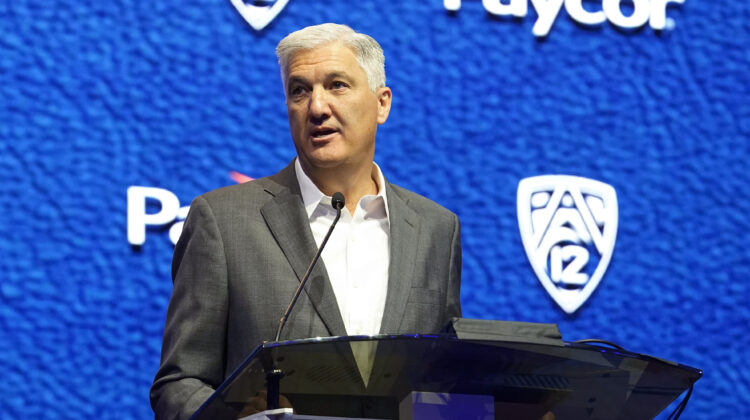In an alternate universe, Pac-12 commissioner George Kliavkoff’s media strategy would have worked brilliantly.
In an alternate universe, Kliavkoff’s lack of urgency, his willingness to let the football season and market forces play out simultaneously, would have led to stability and riches.
In that universe, Kliavkoff convinces the university presidents to bet on themselves, to embrace the on-field hype and extend the media rights negotiations deep into the fall.
Had the conference’s football inventory been available now, this week, today, there would be no shortage of motivated buyers.
Colorado and coach Deion Sanders are the talk of the sport and smashing audience records.
The conference has eight ranked teams and the betting favorites for the Heisman Trophy.
USC is a hot property; so are Washington and Oregon … and Washington State and Oregon State.
Had the presidents remained patient and unified, the Pac-12 would have a media rights proposal on the table that met their requirements for annual revenue and linear television exposure.
They could have used Apple’s bid to drive up the price for ESPN, Fox and any other interested networks — not to Big Ten or SEC levels, of course, but into the mid-$30 million range annually (per school), which would have secured the grant-of-rights signatures from all 10 schools.
In the real world, of course, Kliavkoff’s strategy was an abject failure.
Because in the real world, the presidents were never going to break records for patience. The schools were never going to wade into the 2023 season without a media contract secured for the 2024 season.
Not with their eroding trust in Kliavkoff’s leadership.
Not with the Big 12 and Big Ten sharks circling.
Not with Fox’s strategy serving as a clear and present danger.
Not with the fiscal and psychological scars rooted in years of mismanagement, misguided strategy and missed opportunities.
Here were 10 schools, battered and beleaguered by former commissioner Larry Scott’s unrealistic revenue projections; by the Pac-12 Networks epic distribution miss; by the hollow promises of riches and glory that would result from owning and operating a media company.
And along came Kliavkoff, asking them to sit back and let market forces carry the Pac-12 into a new era, play the digital behemoths against the linear stalwarts and dare to be different. He loved the strategy. They didn’t. It simply wasn’t in their DNA.
Which brings us to the Pac-12’s word of the day, month, year, decade and forever: disconnect.
The collapse of a 108-year-old college sports institution cannot be blamed on a single person, entity or event. It required an unfathomable series of wrong turns over the course of a dozen years. If just one move, one decision, one vote had gone the other way, the conference would be alive and well right now.
The Pac-12 needed the coin to land on heads just once. Instead, it got tails every time.
You only land on that outcome if, at the root of every decision, there is a fundamental disconnect:
— Between Larry Scott and the athletic directors, which lasted years and removed vital institutional knowledge from the Pac-12’s decision-making process on strategic matters.
— Between the disengaged presidents and the roiling reality of college sports, which led the conference to make a series of baffling decisions and ultimately sent the Pac-12 hurtling down the road to the abyss.
— Between what the presidents thought they needed in a replacement for Scott and what they actually needed. At the time, in the spring of 2021, the conference was desperate for a leader who brought a keen understanding of college football and deep industry connections. A leader who knew where to turn and what to avoid.
Instead, they hired an outsider, Kliavkoff, who thought he would be swimming with goldfish and not Great Whites.
— Between Kliavkoff’s media strategy and the needs and desires of his schools. He should have realized their patience would wear thin. He should have known they needed a linear partner. He should have been wary of the external pressures undermining faith in the process.
Successful commissioners set realistic goals that match membership needs. They build consensus, they push back against fanciful notions, they brace for setbacks, prepare for unknowns, establish trust and, ultimately, reach a destination that works for the schools.
Instead, with his presidents focused on the shifting, fragile landscape underfoot, Kliavkoff turned his gaze to a risky but potentially lucrative target in a galaxy far, far away.
Related posts:

(AP Photo/Ralph Freso, File)
Wilner – Today’s Big 12 Makeover, Impact on Pac-12
(AP Photo/Ralph Freso, File)
Wilner – Pac-12 collapse: Tracing the 12 strategic blunders that led to Doomsday Mailbag: Stanford and Cal caught in ACC breakup(?), Big Ten revenue shares, the Pac-2 lawsuit, media decisions and more
Mailbag: Stanford and Cal caught in ACC breakup(?), Big Ten revenue shares, the Pac-2 lawsuit, media decisions and more

Southern California wide receiver Brenden Rice, (AP Photo/David Zalubowski)
Saturday Night Five: USC’s offensive defense, UW’s desert escape, Cal’s big win and more

